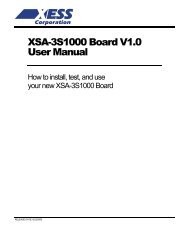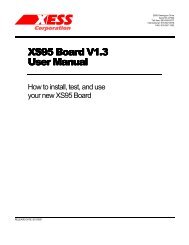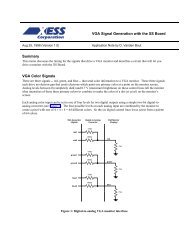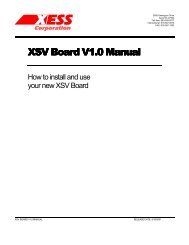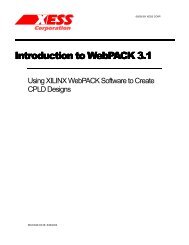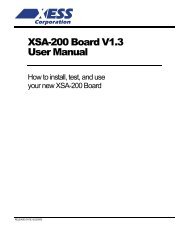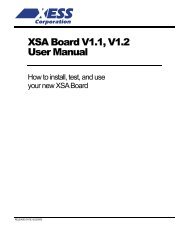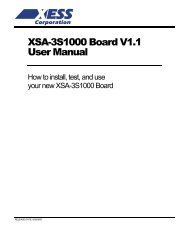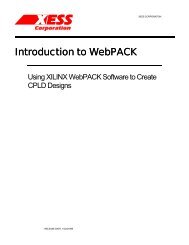Running Foundation from a Makefile - Xess
Running Foundation from a Makefile - Xess
Running Foundation from a Makefile - Xess
You also want an ePaper? Increase the reach of your titles
YUMPU automatically turns print PDFs into web optimized ePapers that Google loves.
<strong>Running</strong> <strong>Foundation</strong> <strong>from</strong> a<br />
<strong>Makefile</strong><br />
RELEASE DATE: 12/5/99<br />
©1999 BY X ENGINEERING SOFTWARE SYSTEMS CORP.
Introduction<br />
In this document, I will describe how I use a makefile to compile VHDL code into<br />
bitstreams for XILINX FPGAs and CPLDs. The makefile sets up the options and<br />
runs the individual software tools in <strong>Foundation</strong>. This gives me the following benefits:<br />
Automation: I can start a makefile script running and leave. I no longer have to<br />
guide <strong>Foundation</strong> through the phases of compilation using the GUI.<br />
Fewer Errors: It’s always possible to make an error or forget to set an option<br />
when I point and click with the <strong>Foundation</strong> GUI. The makefile encapsulates<br />
the options for my design and they are consistently applied whenever<br />
I recompile.<br />
Simpler Archiving: I can use a revision control system to archive my design just<br />
by checking-in the makefile, VHDL files, constraint files, and a few files<br />
containing the design options. I don’t have to store any strange binary files<br />
which are incompatible between different versions of the software tools,<br />
and I don’t need to store the entire project directory hierarchy.<br />
That said, there are disadvantages to using a makefile when I am developing the<br />
first version of a design. The non-interactive nature of makefiles makes error<br />
reporting and correction of my VHDL files more difficult. And it is difficult to<br />
remember the correct settings for all the compilation options. So I like to use the<br />
<strong>Foundation</strong> GUI when I develop a design. Once the design is working, I move all<br />
the settings for the options into the appropriate places in my scripts.<br />
XESS CORP. WWW.XESS.COM 1
Caveats<br />
I am assuming you have the following UNIX-like utilities on your PC: make, rm,<br />
cat, echo, and mv. These are necessary to run the makefile. You can get these utilities<br />
<strong>from</strong> several sites on the Web.<br />
You will also need the fe_shell utility that lets you run the FPGA Express synthesizer<br />
<strong>from</strong> a command script. This utility is not included in the Student Edition<br />
of the XILINX <strong>Foundation</strong> tools.<br />
XESS CORP. WWW.XESS.COM 2
<strong>Makefile</strong> Design Flow<br />
Here is a high-level view of how I use makefiles to compile a bitstream:<br />
1. I edit the files which store the parameters which control some aspects of the<br />
synthesis and implementation process. These files are fe.fst, hitop.ctl,<br />
and bitgen.ut.<br />
2. I edit the makefile which controls the overall sequence of compilation steps.<br />
This typically involves specifying the names of the VHDL source files and<br />
libraries and selecting the type of device which will be targeted.<br />
3. I invoke the makefile. The makefile starts FPGA Express to synthesize the<br />
VHDL into an XNF file (XILINX netlist format file). Then the makefile runs<br />
the appropriate design implementation tools to generate either an FPGA .BIT<br />
file or a CPLD .SVF file.<br />
The <strong>Makefile</strong><br />
A makefile for compiling a simple VHDL design for an XC4000 FPGA and an<br />
XC9500 CPLD is shown below. It looks complicated. XILINX built their <strong>Foundation</strong><br />
GUI to hide all this <strong>from</strong> you. I will explain what each line does below.<br />
1 FEXP = C:/fndtn/synth/bin-wi~1/fe_shell.exe<br />
2 FEXP_FST_TEMPLATE = fe.fst<br />
3 CTL_TEMPLATE = hitop.ctl<br />
4 TOP = leddcd<br />
5<br />
6 all: xs40-005xl xs95-108<br />
7<br />
8 clean:<br />
9 rm -f *.log *.bld *.mrp *.ngd *.pro *.pad \<br />
10 *.pcf *.xbt *.jed *.ngm *.tsp *.ngo *.gyd \<br />
11 *.lst *.vm6 *.cmd *.ncd *.dly *.bgn *.drc \<br />
12 *.ll *.rpt *.par<br />
13<br />
14 extra_clean: clean<br />
15 rm -rf $(TOP)<br />
XESS CORP. WWW.XESS.COM 3
16 rm -rf DPM_NET<br />
17 rm -f *.bit<br />
18 rm -f *.svf<br />
19<br />
20 xs40-005xl: FEXP_TARGET = XC4000XL<br />
21 xs40-005xl: FEXP_DEVICE = 4005XLPC84<br />
22 xs40-005xl: DEVICE = xc4005xl-3-pc84<br />
23 xs40-005xl: BIT_FILE = ledcd05x.bit<br />
24 xs40-005xl: FST_FILE = fe05xl.fst<br />
25 xs40-005xl: VHDL = “{leddcd.vhd}”<br />
26 xs40-005xl: LIB = “xsboard”<br />
27 xs40-005xl: LIB_VHDL = “{xsboard.vhd}”<br />
28 xs40-005xl: FPGA_UCF = leddcd40.ucf<br />
29 xs40-005xl:<br />
30 $(mk_fpga_fst_file)<br />
31 $(mk_fpga)<br />
32 rm -f $(FST_FILE)<br />
33<br />
34 xs95-108: FEXP_TARGET = XC9500<br />
35 xs95-108: FEXP_DEVICE = 95108PC84<br />
36 xs95-108: CTL_DEVICE = XC95108-15-PC84<br />
37 xs95-108: DEVICE = XC95108<br />
38 xs95-108: SVF_FILE = ledcd108.svf<br />
39 xs95-108: FST_FILE = fe108.fst<br />
40 xs95-108: VHDL = “{leddcd.vhd}”<br />
41 xs95-108: LIB = “xsboard”<br />
42 xs95-108: LIB_VHDL = “{xsboard.vhd}”<br />
43 xs95-108: CPLD_UCF = leddcd95.ucf<br />
44 xs95-108:<br />
45 $(mk_cpld_fst_file)<br />
46 $(mk_cpld)<br />
47 rm -f $(FST_FILE)<br />
48<br />
49<br />
50 define mk_fpga_fst_file<br />
51 echo “set proj $(TOP)” > $(FST_FILE)<br />
52 echo “set vhdl $(VHDL)” >> $(FST_FILE)<br />
53 echo “set top $(TOP)” >> $(FST_FILE)<br />
54 echo “set chip $(TOP)” >> $(FST_FILE)<br />
55 echo “set target $(FEXP_TARGET)” >> $(FST_FILE)<br />
56 echo “set device $(FEXP_DEVICE)” >> $(FST_FILE)<br />
57 echo “set lib $(LIB)” >> $(FST_FILE)<br />
XESS CORP. WWW.XESS.COM 4
58 echo “set lib_vhdl $(LIB_VHDL)” >> $(FST_FILE)<br />
59 echo “proj_fsm_coding_style = \”onehot\”” >> $(FST_FILE)<br />
60 cat $(FEXP_FST_TEMPLATE) >> $(FST_FILE)<br />
61 endef<br />
62<br />
63 define mk_fpga<br />
64 $(FEXP) -f $(FST_FILE)<br />
65 ngdbuild -p $(DEVICE) -uc $(FPGA_UCF) -dd . -nt on \<br />
66 DPM_NET/$(TOP).xnf $(TOP).ngd<br />
67 map -p $(DEVICE) -o map.ncd $(TOP).ngd $(TOP).pcf<br />
68 par -x -w -ol 2 -d 0 map.ncd $(TOP).ncd $(TOP).pcf<br />
69 bitgen $(TOP).ncd -l -w -f bitgen.ut<br />
70 mv $(TOP).bit $(BIT_FILE)<br />
71 endef<br />
72<br />
73 define mk_cpld_fst_file<br />
74 echo “set proj $(TOP)” > $(FST_FILE)<br />
75 echo “set vhdl $(VHDL)” >> $(FST_FILE)<br />
76 echo “set top $(TOP)” >> $(FST_FILE)<br />
77 echo “set chip $(TOP)” >> $(FST_FILE)<br />
78 echo “set target $(FEXP_TARGET)” >> $(FST_FILE)<br />
79 echo “set device $(FEXP_DEVICE)” >> $(FST_FILE)<br />
80 echo “set lib $(LIB)” >> $(FST_FILE)<br />
81 echo “set lib_vhdl $(LIB_VHDL)” >> $(FST_FILE)<br />
82 echo “proj_fsm_coding_style = \”binary\”” >> $(FST_FILE)<br />
83 cat $(FEXP_FST_TEMPLATE) >> $(FST_FILE)<br />
84 endef<br />
85<br />
86 define mk_cpld<br />
87 $(FEXP) -f $(FST_FILE)<br />
88 ngdbuild -p $(DEVICE) -uc $(CPLD_UCF) -dd . -nt on \<br />
89 DPM_NET/$(TOP).xnf $(TOP).ngd<br />
90 echo DEVICE_OPTIONS: $(CTL_DEVICE) > $(TOP).ctl<br />
91 cat $(CTL_TEMPLATE) >> $(TOP).ctl<br />
92 hitop -f $(TOP).ngd -s -o $(TOP)<br />
93 hplusas6 -i $(TOP) -s -a -l $(TOP).log -o $(TOP)<br />
94 hprep6 -i $(TOP) -r jed -a<br />
95 echo part $(DEVICE):$(TOP) > $(TOP).cmd<br />
96 echo program $(TOP) -j $(TOP) >> $(TOP).cmd<br />
97 echo quit >> $(TOP).cmd<br />
98 rm -f $(TOP).SVF<br />
99 jtagprog -svf -batch $(TOP).cmd<br />
XESS CORP. WWW.XESS.COM 5
100 mv $(TOP).SVF $(SVF_FILE)<br />
101 rm -f $(TOP).cmd<br />
102 rm -f $(TOP).ctl<br />
103 endef<br />
Lines 1-2: The FEXP variable is defined that points to the location of my<br />
fe_shell executable. (Yours may be in a different place or you might not<br />
even have this program if you are using the Student Edition of <strong>Foundation</strong>.)<br />
fe_shell is a program that lets you control the FPGA Express synthesis<br />
tool using text commands. It will also execute a sequence of commands<br />
stored in a script file. The FEXP_FST_TEMPLATE variable points to the<br />
basic synthesis script template that I use. I keep a separate synthesis script<br />
template in each of my project directories in case I need different synthesis<br />
options for a particular project.<br />
Line 3: The CTL_TEMPLATE variable points to the file which stores the options that<br />
control the process of fitting the design into a CPLD. I keep a separate<br />
CPLD control template in each of my project directories in case I need different<br />
fitting options for a particular project.<br />
Line 4: The TOP variable stores the name of the top-level module in my VHDL<br />
design. This name is used as the base name for a lot of the files generated<br />
during the compilation process.<br />
Line 6: I list my targets here. In this example I am targeting an XS40-005XL<br />
Board (which has an XC4005XL FPGA on it) and an XS95-108 Board<br />
(which has an XC95108 CPLD on it). These are just my personal choices -<br />
you can use any names for targets. To compile the bitfiles for both the<br />
XS40-005XL Board and the XS95-108 Board, I just issue the command<br />
make all.<br />
Lines 8-18: These are two other targets I use to make it easy to remove all the files<br />
generated during the compilation process. To remove all the extra files generated<br />
in my top-level directory, I type make clean. To start <strong>from</strong> a clean<br />
XESS CORP. WWW.XESS.COM 6
slate I type make extra_clean which removes all the extra files, subdirectories,<br />
and previously-compiled bitstream files.<br />
Lines 20-28: These lines set the variables for compiling a bitstream for the XS40<br />
Board. Each line starts with the name of one of the targets <strong>from</strong> line 6<br />
(xs40-005xl in this case). The FEXP_TARGET variable lists the device<br />
family that the FPGA Express synthesizer will be targeting, while the<br />
FEXP_DEVICE variable indicates the particular device within that family.<br />
The FST_FILE variable stores the name of the file that holds the command<br />
script for the synthesizer. The DEVICE variable tells the <strong>Foundation</strong> implementation<br />
tools the which device, speed grade, and package type they will<br />
be targeting. In this example, the target is a -3 speed XC4005XL FPGA in<br />
an 84-pin PLCC. (The DEVICE variable seems redundant given that we<br />
already have this information in the FEXP_TARGET and FEXP_DEVICE<br />
variables, but the variables are intended for two separate tools and I don’t<br />
have a simple way to generate one <strong>from</strong> the other.) The BIT_FILE variable<br />
indicates the file where I want the final bitstream stored. The VHDL variable<br />
lists the names of the VHDL source files in my design separated by spaces.<br />
(There is only the leddcd.vhd VHDL file in this design.) The LIB variable<br />
lists the name of the master library for my design. The LIB_VHDL<br />
variable holds the list of VHDL source files that are to be included in the<br />
master library. (If you don’t use a library in your design, just set LIB to the<br />
string \”\”.) The FPGA_UCF variable points to the file that stores the pin<br />
assignments and timing constraints for my design.<br />
Lines 29-32: The actual synthesis and implementation for the FPGA occur on<br />
these lines. $(mk_fpga_fst_file) executes a procedure defined in the<br />
makefile (lines 50-61) that generates the script file for controlling the<br />
FPGA Express synthesizer. Then $(mk_fpga) executes another procedure<br />
defined in the makefile (lines 63-71) that runs the synthesizer and the<br />
implementation tools to generate a bitstream. The last line removes the<br />
script that controls the synthesizer.<br />
Lines 34-43: These lines set the variables for compiling a bitstream for the XS95<br />
Board. Each line starts with the name of one of the targets <strong>from</strong> line 6<br />
(xs95-108 in this case). The FEXP_TARGET variable lists the device fam-<br />
XESS CORP. WWW.XESS.COM 7
ily that the FPGA Express synthesizer will be targeting, while the<br />
FEXP_DEVICE variable indicates the particular device within that family.<br />
The FST_FILE variable stores the name of the file that holds the command<br />
script for the synthesizer. The CTL_DEVICE variable tells the <strong>Foundation</strong><br />
implementation tools the which device, speed grade, and package type they<br />
will be targeting. In this example, the target is a -15 ns XC95108 CPLD in<br />
an 84-pin PLCC. The DEVICE variable names the generic family of<br />
devices that will be targeted by the implementation tools. (The<br />
CTL_DEVICE and DEVICE variables seem redundant given that we already<br />
have this information in the FEXP_TARGET and FEXP_DEVICE variables,<br />
but the variables are intended for two separate tools and I don’t have a simple<br />
way to generate one <strong>from</strong> the other.) The SVF_FILE variable indicates<br />
the file where I want the final bitstream stored. The VHDL variable lists the<br />
names of the VHDL source files in my design separated by spaces. (There<br />
is only the leddcd.vhd VHDL file in this design.) The LIB variable lists<br />
the name of the master library for my design. The LIB_VHDL variable<br />
holds the list of VHDL source files that are to be included in the master<br />
library. (If you don’t use a library in your design, just set LIB to the string<br />
\”\”.) The CPLD_UCF variable points to the file that stores the pin assignments<br />
and timing constraints for my design.<br />
Lines 44-47: The actual synthesis and implementation for the CPLD occur on<br />
these lines. $(mk_cpld_fst_file) executes a procedure defined in the<br />
makefile (lines 73-84) that generates the script file for controlling the<br />
FPGA Express synthesizer. Then $(mk_cpld) executes another procedure<br />
defined in the makefile (lines 86-103) that runs the synthesizer and the<br />
implementation tools to generate a bitstream. The last line removes the<br />
script that controls the synthesizer.<br />
Lines 50-61: The mk_fpga_fst_file procedure is defined on these lines. This<br />
procedure generates the script file that controls the operations of the FPGA<br />
Express synthesizer. The first eight lines of this procedure just set up the<br />
variables in the synthesizer script file pointed to by the FST_FILE variable.<br />
These variables define the project name, VHDL files, top-level module<br />
name, chip name, targeted FPGA family, FPGA family device, VHDL<br />
master library, and master library VHDL source files. Then the coding style<br />
XESS CORP. WWW.XESS.COM 8
for finite-state machines is set to onehot (which is usually the best setting<br />
for FPGAs). Finally, the commands in the FEXP_FST_TEMPLATE file are<br />
appended to the file pointed to by FST_FILE. At this point, a complete<br />
synthesis script for an FPGA exists in the file pointed to by FST_FILE.<br />
Lines 63-71: These lines define the mk_fpga procedure. The first line of the procedure<br />
passes the synthesis script to the FPGA Express synthesizer. After<br />
the synthesizer completes its operations, the next line in the procedure activates<br />
the ngdbuild implementation tool. ngdbuild converts the XILINX<br />
netlist file created in DPM_NET/$(TOP).xnf by the synthesizer into the<br />
NGD format that is understood by the rest of the implementation tools. Then<br />
the map tool is activated that maps the circuitry described in the<br />
$(TOP).ngd file to the architecture of the FPGA device. The mapping is<br />
passed to the par tool on the next line which performs a place-and-route of<br />
the circuitry. Finally, the bitstream for the routed circuit is generated by the<br />
bitgen tool under the influence of the options stored in the bitgen.ut<br />
file. The bitstream file is moved into the file pointed to by the BIT_FILE<br />
variable. (I usually get these command lines <strong>from</strong> the fe.log file in the<br />
xproj/veri/revj subdirectory after I have finished developing the<br />
design using the <strong>Foundation</strong> GUI.)<br />
Lines 73-84: The mk_cpld_fst_file procedure is defined on these lines. This<br />
procedure generates the script file that controls the operations of the FPGA<br />
Express synthesizer. The first eight lines of this procedure just set up the<br />
variables in the synthesizer script file pointed to by the FST_FILE variable.<br />
These variables define the project name, VHDL files, top-level module<br />
name, chip name, targeted CPLD family, CPLD family device, VHDL<br />
master library, and master library VHDL source files. Then the coding style<br />
for finite-state machines is set to binary (which is usually the best setting<br />
for CPLDs). Finally, the commands in the FEXP_FST_TEMPLATE file are<br />
appended to the file pointed to by FST_FILE. At this point, a complete<br />
synthesis script for an CPLD exists in the file pointed to by FST_FILE.<br />
Lines 86-103: These lines define the mk_cpld procedure. The first line of the procedure<br />
passes the synthesis script to the FPGA Express synthesizer. After<br />
the synthesizer completes its operations, the next line in the procedure acti-<br />
XESS CORP. WWW.XESS.COM 9
vates the ngdbuild implementation tool. ngdbuild converts the XILINX<br />
netlist file created in DPM_NET/$(TOP).xnf by the synthesizer into the<br />
NGD format that is understood by the rest of the implementation tools. Next,<br />
a control file that holds the various CPLD fitting parameters is created in<br />
the file with the name $(BASE).ctl. The first line of the control file specifies<br />
the type of CPLD that is being targeted. Then the options stored in the<br />
file pointed to by CTL_TEMPLATE are appended to the control file. The<br />
control file directs the operations of the hitop, hplusas6, and hprep6<br />
tools on the next three lines. (I usually get these three lines <strong>from</strong> the<br />
fe.log file in the xproj/veri/revj subdirectory after I have finished<br />
developing the design using the <strong>Foundation</strong> GUI.) The resulting JEDEC<br />
file output by hprep6 must be converted to an SVF bitstream file. jtagprog<br />
is directed to generate the SVF file for given type of CPLD and then<br />
terminate by the three commands stored in the $(TOP).cmd file. The bitstream<br />
file is moved into the file pointed to by the SVF_FILE variable.<br />
Then the command and control files which were created previously are<br />
removed.<br />
The Synthesis Script Template (fe.fst)<br />
The synthesis script template is stored in a file pointed to by the<br />
FEXP_FST_TEMPLATE variable in the makefile. The template contains synthesis<br />
commands which don’t usually change <strong>from</strong> one design to another. An example<br />
script template that I often use is shown below.<br />
1 set export_dir DPM_NET<br />
2<br />
3 file delete -force $proj<br />
4<br />
5 create_project -dir . $proj<br />
6<br />
7 open_project $proj<br />
8<br />
9 proj_export_timing_constraints = “no”<br />
10 proj_fsm_when_others = “safest”<br />
11 proj_xlx_ppr = “M1”<br />
12 proj_default_clock_frequency = 50<br />
13<br />
XESS CORP. WWW.XESS.COM 10
14 if {$lib != ““} {<br />
15 create_library $lib<br />
16 foreach i $lib_vhdl {<br />
17 add_file -library $lib -format VHDL $i<br />
18 }<br />
19 }<br />
20<br />
21 foreach i $vhdl {<br />
22 add_file -format VHDL $i<br />
23 }<br />
24<br />
25 analyze_file -progress<br />
26<br />
27 create_chip -progress -target $target -device $device -name $chip $top<br />
28<br />
29 current_chip $chip<br />
30<br />
31 set opt_chip $chip-Optimized<br />
32<br />
33 optimize_chip -progress -name $opt_chip<br />
34<br />
35 list_message<br />
36<br />
37 file delete -force $export_dir<br />
38 file mkdir $export_dir<br />
39<br />
40 export_chip -progress -dir $export_dir<br />
41<br />
42 close_project<br />
43<br />
44 exit<br />
This script is adapted to various designs when the makefile prepends the assignments<br />
for the proj, vhdl, top, chip, target, device, lib, and lib_vhdl<br />
variables. The template then performs the following functions:<br />
Line 1: This line specifies the subdirectory where FPGA Express will place its<br />
synthesis results. In this example, the subdirectory is hard-coded to<br />
DPM_NET.<br />
XESS CORP. WWW.XESS.COM 11
Lines 3-7: Any existing project with the same name as that stored in the proj variable<br />
will be deleted. This removes any old files that could affect the current<br />
synthesis process. Then a new project with the name stored in the proj<br />
variable is created and opened.<br />
Line 9: FPGA Express is directed not to export any timing constraints <strong>from</strong> the<br />
synthesis process on to the implementation tools.<br />
Line 10: When VHDL is synthesized, all state machines are coded to transition to a<br />
safe state if an unspecified state is ever entered.<br />
Line 11: The place-and-route implementation tools is specified to be the one found<br />
in the XILINX M1 tools.<br />
Line 12: The minimum operational frequency for the synthesized design is specified<br />
to be 50 MHz.<br />
Lines 14-19: If the master library name in lib is not blank, then the VHDL source<br />
files listed in the lib_vhdl variable are each added to the master library.<br />
Lines 21-23: The VHDL source files listed in the vhdl variable are added to the<br />
project.<br />
Line 25: The VHDL files are analyzed for syntax errors. Any syntax errors will<br />
cause the script to terminate.<br />
Line 27: The VHDL source is synthesized into a netlist for the given target family<br />
and device. The top variable tells the synthesizer which module is at the<br />
top of the design hierarchy. The synthesized netlist is associated with a chip<br />
having the name stored in the chip variable.<br />
Line 29: The synthesized chip is specified as the current chip that will be optimized.<br />
Line 31: The variable opt_chip is declared and set to the name of the current chip<br />
with a suffix of “-Optimized”.<br />
XESS CORP. WWW.XESS.COM 12
Line 33: The synthesized netlist output by the operations on line 27 are optimized<br />
for the target device architecture.<br />
Line 35: This line directs the FPGA Express to output various status messages<br />
which occur during the synthesis process.<br />
Lines 37-38: The directory where the optimized netlist will be exported is deleted<br />
(to remove any old netlists) and then recreated.<br />
Line 40: The netlist <strong>from</strong> the optimization step is exported as an XNF file to the<br />
directory named in export_dir.<br />
Line 42: The current project is closed.<br />
Line 44: The script terminates.<br />
The Bitstream Generator Control File (bitgen.ut)<br />
This file specifies the options that control the FPGA bitstream generator. bitgen.ut<br />
is not used when I generate SVF files for CPLD devices. An example of a<br />
bitgen.ut file is shown below:<br />
1 -g ConfigRate:SLOW<br />
2 -g TdoPin:PULLNONE<br />
3 -g M1Pin:PULLNONE<br />
4 -g DonePin:PULLUP<br />
5 -g CRC:enable<br />
6 -g StartUpClk:CCLK<br />
7 -g SyncToDone:no<br />
8 -g DoneActive:C1<br />
9 -g OutputsActive:C3<br />
10 -g GSRInactive:C4<br />
11 -g ReadClk:CCLK<br />
12 -g ReadCapture:enable<br />
13 -g ReadAbort:disable<br />
14 -g M0Pin:PULLNONE<br />
15 -g M2Pin:PULLNONE<br />
XESS CORP. WWW.XESS.COM 13
In general, I usually copy the bitgen.ut file generated by the <strong>Foundation</strong> GUI<br />
after I finally have the design development completed. The file is usually found in<br />
the xproj/veri/revj subdirectory where i and j are the version and revision<br />
number of my final design.<br />
The CPLD Fitter Control Template File (hitop.ctl)<br />
This file specifies the options which control the CPLD fitting process. It is not<br />
used if I am only targeting FPGA devices. An example of a CPLD fitter control<br />
file is shown below:<br />
1 DT_SYNTHESIS:TRUE<br />
2 MC9500_INPUT_LIMIT:36<br />
3 GSR_OPT:TRUE<br />
4 FASTCLOCK_OPT:TRUE<br />
5 FOE_OPT:TRUE<br />
6 MC9500_PTERM_LIMIT:20<br />
7 TIMING_OPT:TRUE<br />
8 LOWPWR:STD<br />
9 SLEW:FAST<br />
10 DRIVE_UNUSED_IO:FALSE<br />
11 IGNORE_PIN_ASSIGNMENT:FALSE<br />
12 FM_PARTITION:TRUE<br />
13 CREATE_LOCAL_FEEDBACK:TRUE<br />
14 CREATE_PIN_FEEDBACK:TRUE<br />
15 IGNORE_TSPEC:FALSE<br />
16 MULTI_LEVEL_LOGIC_OPTIMIZATION:TRUE<br />
In general, I usually copy the hitop.ctl file generated by the <strong>Foundation</strong> GUI<br />
after I finally have the design development completed. The file is usually found in<br />
the xproj/veri/revj subdirectory where i and j are the version and revision<br />
number of my final design.<br />
XESS CORP. WWW.XESS.COM 14
LED Decoder Design Example<br />
The example design included with this document consists of the following files:<br />
leddcd.vhd: This is the top-level module of a circuit which accepts a four-bit<br />
input and displays the corresponding hexadecimal digit on a 7-segment<br />
LED.<br />
xsboard.vhd: This is a library file that contains several modules, one of which is<br />
an LED decoder used by the top-level leddcd module.<br />
leddcd40.ucf: This file contains the pin assignments for the leddcd design<br />
when it is targeted to an XS40 Board.<br />
leddcd95.ucf: This file contains the pin assignments for the leddcd design<br />
when it is targeted to an XS95 Board.<br />
fe.fst: This is the FPGA Express script template that was discussed earlier.<br />
hitop.ctl: This is the CPLD fitter control file that was discussed earlier.<br />
bitgen.ut: This is the bitstream generator control file that was discussed earlier.<br />
makefile: This is the makefile that compiles the leddcd design for both the<br />
XS40 and XS95 Boards.<br />
Just place these files into a directory. The LED decoder is compiled for both the<br />
XS40 and XS95 Boards by issuing the following command in a DOS window:<br />
C:> make all<br />
You can compile the design for either the XS40 or XS95 Board with the commands:<br />
C:> make xs40-005xl<br />
XESS CORP. WWW.XESS.COM 15
C:> make xs95-108<br />
After the makefile is done, you will find the FPGA bitstream in ledcd05x.bit<br />
and the CPLD bitstream in ledcd108.svf.<br />
After compiling the design, you can clean the directory with the command:<br />
C:> make clean<br />
To clean the directory and remove the subdirectories and the bitstreams, use the<br />
command:<br />
C:> make extra_clean<br />
XESS CORP. WWW.XESS.COM 16
Modifying the Files for Your Own Designs<br />
Here is a summary of the steps I go through to develop a makefile and script files<br />
for a design:<br />
1. Develop the initial version of the design using the <strong>Foundation</strong> GUI.<br />
2. Create an empty directory for the project scripts and copy the makefile and<br />
fe.fst files <strong>from</strong> the script directory of a previous project. (You could use the<br />
makefile and fe.fst files <strong>from</strong> the LED decoder example as your starting<br />
point.) Then copy the bitgen.ut and hitop.ctl files <strong>from</strong> the xproj/<br />
veri/revj directory created in step 1.<br />
3. Set the following variables for each target architecture in the makefile:<br />
TOP: Set it to the name of the top-level module of the design.<br />
FEXP_TARGET: Set it to one of the family of devices recognized by FPGA<br />
Express.<br />
FEXP_DEVICE: Set it to one of the members of the device family.<br />
DEVICE: Set it to the detailed name of the FPGA device (e.g. DEVICE =<br />
xc4010e-3-pc84) or the shortened name of the CPLD device<br />
(e.g. DEVICE = XC95108).<br />
CTL_DEVICE: For CPLD designs, set it to the detailed name of the target<br />
device (e.g. CTL_DEVICE = XC95108-15-PC84). This variable is<br />
not used in FPGA designs.<br />
BIT_FILE/SVF_FILE: Set these to the name of the final BIT or SVF file.<br />
VHDL: Set it to a space-separated list of VHDL files for the design (e.g.<br />
VHDL = "{file1.vhd file2.vhd}").<br />
XESS CORP. WWW.XESS.COM 17
LIB: Set it to the name of the master library used in the design or make it<br />
empty if no library is needed (i.e. LIB = \"\").<br />
LIB_VHDL: Set it to the list of files to be included in the library using the<br />
same space-separated format as with the VHDL variable.<br />
FPGA_UCF/CPLD_UCF: Set these to the names of the pin assignment files<br />
for the FPGA and CPLD designs.<br />
4. Edit fe.fst to change or add FPGA Express settings.<br />
5. Edit hitop.ctl to adjust fitter options for the CPLD.<br />
6. Edit bitgen.ut to adjust bitmap generation options for the FPGA.<br />
XESS CORP. WWW.XESS.COM 18
“It Doesn’t Work!”<br />
You may encounter problems when you try to compile the LED decoder example<br />
or designs of your own. You can usually solve VHDL syntax errors or problems<br />
with option settings by first compiling the design using the <strong>Foundation</strong> GUI. Then<br />
you can extract the correct VHDL and the control options <strong>from</strong> the debugged<br />
project and include them in your makefile and template files.<br />
If you just can’t stand to use the <strong>Foundation</strong> GUI (i.e. you started with the UNIX<br />
command line interface and you intend to die that way), then you will have to run<br />
the makefile and watch for error messages as they appear and then go into the<br />
offending file and fix it. It’s not impossible to do, but it’s not the most efficient use<br />
of your time. Any way, it’s your call so do what you want.<br />
You may encounter problems you don’t immediately understand or whose solution<br />
is not immediately obvious. First I will tell you what not to do: do not send email<br />
to XESS Corp. requesting help! I have received a few too many messages over the<br />
years which read like this:<br />
“I do as you say but when I run makefile it no working. What is<br />
wrong Please help me!”<br />
Please! If I could fix problems based on a description like that, then I would make<br />
my living as a psychic.<br />
There are better ways to approach the problem. The first is to say:<br />
“Well, I didn’t know how to use a makefile to run the XILINX tools<br />
before, so if this script doesn’t work I’m no worse off than I was.<br />
I’ll just chuck it and go back to doing it the way I used to.”<br />
Surprisingly, this is usually a pretty good response. But for those who won’t give<br />
up, you can employ the following attitude:<br />
XESS CORP. WWW.XESS.COM 19
“Well, the makefile isn’t running but I’ll bet it’s 95% of the way<br />
there. I’m probably smarter than the guy that wrote it so I should be<br />
able to figure out the last 5% and make it work for me.”<br />
Then if you solve the problem, feel free to send me a good description of how the<br />
problem occurred and how you solved it. If I ever revise this document, I will<br />
include your insights so that others can benefit <strong>from</strong> them.<br />
XESS CORP. WWW.XESS.COM 20
Future Enhancements<br />
The makefile and scripts I have described are simple but they get the job done for<br />
me. Their most noticeable deficiency is that they don’t use the file dependency features<br />
of make. So all the files are recompiled <strong>from</strong> scratch whenever you run make.<br />
It would be more efficient if the makefile recognized the existence of intermediate<br />
files and could resume the compilation process <strong>from</strong> that point. Maybe someone<br />
else will make that enhancement.<br />
XESS CORP. WWW.XESS.COM 21




